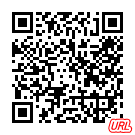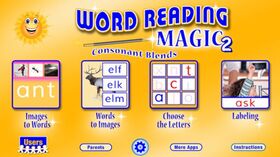WORD READING MAGIC 2 |
| この情報はストアのものより古い可能性がございます。 | ||||
| 価格 | 無料 | ダウンロード |
||
|---|---|---|---|---|
| ジャンル | 教育 | |||
サイズ | 238.0MB (ダウンロードにWIFIが必要) | |||
| 開発者 | PRESCHOOL UNIVERSITY | |||
| 順位 |
| |||
| リリース日 | 2019-12-14 17:00:00 | 評価 |
|
|
| 互換性 | iOS 10.0以降が必要です。 iPhone、iPad および iPod touch 対応。 | |||
Word Reading Magic 2 can help your child’s future reading success.
It is best to focus on “BLENDING” instead of “blends.”
Teaching the blending together of the sounds in a word is the most efficient way to teach the reading of words containing adjacent consonants. BLENDING is helping the child blend together the four distinct sounds of /h/ + /a/ + /n/ + /d/ into the word “hand.”
On the other hand, teaching and memorizing lists of adjacent consonants combinations, as many programs do, such as fl, bl, st, is inefficient, confusing, and a disservice to emerging readers. With adjacent consonants, such as the s and t in the word “step,” each letter retains its sound even though they are spoken closely together. No new sounds are made by these types of adjacent consonants. The misinformed theory behind teaching consonant blend lists is that these two adjacent consonants make a different sound when, in reality, no new sound is created.
There are situations where two adjacent consonants make a new and different sound. For example, the letters s and h, when combined, make the distinct sound /sh/, as in the word “ship.’” Another example would be the letters c and h, which, when combined, make the distinct sound /ch/ as in “chair.” These, however, are unique types of adjacent consonants called digraphs. The teaching of digraphs is an integral part of proper reading instruction.
There is a distinct difference between teaching digraphs and teaching consonant blends. There is a cultural myth that persists in some early childhood literacy methods of teaching adjacent consonants as if they were digraphs. The real key to successfully dealing with adjacent consonants is to teach the skill of blending (not blend lists) and then to teach the approximately 44 digraphs and trigraphs later.
Most of the programs that teach consonant blends (excluding the digraphs) have 25 beginning 2-letter blends such as bl, fr, tr, and str. These programs also include 16 ending blends such as st, mp, lp, rand ft. That adds up to 41 non-digraph consonant clusters in all. That is a lot of work devoted to teaching a method that is not clear and specific to emerging readers.
The most glaring error with teaching consonant blend lists is that these programs make of using word lists containing advanced phonograms and advanced spelling rules. Using the words “trade,” “triangle,” “trike,” “triple,” “treat,” “tree,” “true,” and “try” to teach the consonant blend “tr” can be very confusing to the child. How is a child supposed to read the words on this list when they are at the beginning stages of learning to read consonant blends? This is a huge leap of faith. This method would be like trying to teach a stomach crawling baby to crawl on their hands and knees by trying to teach the baby to walk. If a child can read the “tr” words on that list, then they are well advanced beyond the reading level of needing to learn the “tr” blend or any consonant blend.
Save yourself and your child from wasting time with the confusing practice of teaching consonant blend lists. Adopt the clear and direct path of teaching the skill of blending to your child and watch them soar in their reading competency.
This app gives your child lots of clear and direct practice of the skill of blending while ignoring the teaching of so-called blends. In using this app, your child will learn how to recognize word patterns and adjacent consonant spelling rules effectively.
Please note, the purpose of this app is to provide many opportunities for practicing the reading of CCVC & CVCC words. On account of this, there are words used in this app that are not in the everyday vocabulary of the young learners using this app. Use this as an opportunity to build vocabulary. The images, when tapped, will always say what they are. There is never any picture guessing required.
Please give us your feedback and suggestions.
更新履歴
Launch screen update. Fixing sidebar issues for greater compatibility with iPhone 10 iPhone 11.
If you like this app, please leave a review.
Reviews REALLY help.
Reviews are much APPRECIATED.
It is best to focus on “BLENDING” instead of “blends.”
Teaching the blending together of the sounds in a word is the most efficient way to teach the reading of words containing adjacent consonants. BLENDING is helping the child blend together the four distinct sounds of /h/ + /a/ + /n/ + /d/ into the word “hand.”
On the other hand, teaching and memorizing lists of adjacent consonants combinations, as many programs do, such as fl, bl, st, is inefficient, confusing, and a disservice to emerging readers. With adjacent consonants, such as the s and t in the word “step,” each letter retains its sound even though they are spoken closely together. No new sounds are made by these types of adjacent consonants. The misinformed theory behind teaching consonant blend lists is that these two adjacent consonants make a different sound when, in reality, no new sound is created.
There are situations where two adjacent consonants make a new and different sound. For example, the letters s and h, when combined, make the distinct sound /sh/, as in the word “ship.’” Another example would be the letters c and h, which, when combined, make the distinct sound /ch/ as in “chair.” These, however, are unique types of adjacent consonants called digraphs. The teaching of digraphs is an integral part of proper reading instruction.
There is a distinct difference between teaching digraphs and teaching consonant blends. There is a cultural myth that persists in some early childhood literacy methods of teaching adjacent consonants as if they were digraphs. The real key to successfully dealing with adjacent consonants is to teach the skill of blending (not blend lists) and then to teach the approximately 44 digraphs and trigraphs later.
Most of the programs that teach consonant blends (excluding the digraphs) have 25 beginning 2-letter blends such as bl, fr, tr, and str. These programs also include 16 ending blends such as st, mp, lp, rand ft. That adds up to 41 non-digraph consonant clusters in all. That is a lot of work devoted to teaching a method that is not clear and specific to emerging readers.
The most glaring error with teaching consonant blend lists is that these programs make of using word lists containing advanced phonograms and advanced spelling rules. Using the words “trade,” “triangle,” “trike,” “triple,” “treat,” “tree,” “true,” and “try” to teach the consonant blend “tr” can be very confusing to the child. How is a child supposed to read the words on this list when they are at the beginning stages of learning to read consonant blends? This is a huge leap of faith. This method would be like trying to teach a stomach crawling baby to crawl on their hands and knees by trying to teach the baby to walk. If a child can read the “tr” words on that list, then they are well advanced beyond the reading level of needing to learn the “tr” blend or any consonant blend.
Save yourself and your child from wasting time with the confusing practice of teaching consonant blend lists. Adopt the clear and direct path of teaching the skill of blending to your child and watch them soar in their reading competency.
This app gives your child lots of clear and direct practice of the skill of blending while ignoring the teaching of so-called blends. In using this app, your child will learn how to recognize word patterns and adjacent consonant spelling rules effectively.
Please note, the purpose of this app is to provide many opportunities for practicing the reading of CCVC & CVCC words. On account of this, there are words used in this app that are not in the everyday vocabulary of the young learners using this app. Use this as an opportunity to build vocabulary. The images, when tapped, will always say what they are. There is never any picture guessing required.
Please give us your feedback and suggestions.
更新履歴
Launch screen update. Fixing sidebar issues for greater compatibility with iPhone 10 iPhone 11.
If you like this app, please leave a review.
Reviews REALLY help.
Reviews are much APPRECIATED.
ブログパーツ第二弾を公開しました!ホームページでアプリの順位・価格・周辺ランキングをご紹介頂けます。
ブログパーツ第2弾!
アプリの周辺ランキングを表示するブログパーツです。価格・順位共に自動で最新情報に更新されるのでアプリの状態チェックにも最適です。
ランキング圏外の場合でも周辺ランキングの代わりに説明文を表示にするので安心です。
サンプルが気に入りましたら、下に表示されたHTMLタグをそのままページに貼り付けることでご利用頂けます。ただし、一般公開されているページでご使用頂かないと表示されませんのでご注意ください。
幅200px版
幅320px版
Now Loading...

「iPhone & iPad アプリランキング」は、最新かつ詳細なアプリ情報をご紹介しているサイトです。
お探しのアプリに出会えるように様々な切り口でページをご用意しております。
「メニュー」よりぜひアプリ探しにお役立て下さい。
Presents by $$308413110 スマホからのアクセスにはQRコードをご活用ください。 →
Now loading...






 (1人)
(1人)